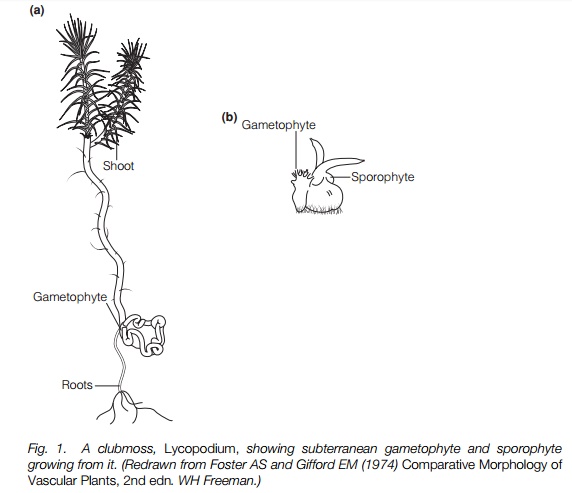Chapter: Plant Biology : Spore bearing vascular plants
Vegetative structure of Lycopsida
Vegetative structure of Lycopsida
The Lycopsida or lycopods today consist of about 1000 species of small non-woody plants known as clubmosses and quillworts, occurring throughout the world. They are mainly terrestrial, and one of the two groups of clubmosses, Selaginella species, can be abundant on the floor of tropical forests. Some are epiphytic while others occur in temperate mountains extending into the Arctic. The Isoetales (quillworts) are mainly aquatic plants. They have no particular human uses.

The living clubmosses (Fig. 1) have a shoot system that branches, often dichotomously, but sometimes with a main stem and side branches. These stems have a central vascular system with no pith and are covered with microphyll leaves. Microphylls (literally ‘small leaves’) are generally small, a few millimeters in length, and characterized by a single vascular strand through the middle. There is no gap in the conducting system of the stem where the leaf branches off. By contrast, the leaves of most other vascular plants, known as megaphylls, have a network of vascular strands and there is a gap in the stem vascular system where the leaf branches off.
Rhizomes may be present and roots branch from them. The roots branch dichotomously and regularly. In Selaginella, the roots branch from a curious structure intermediate between stems and roots, called a rhizophore.
These arise at angles in a stem and are unbranched, often aerial, but form roots when they touch the ground. They may represent a stage at which stems and roots were not fully differentiated.
The quillworts have only a basal corm, a short (about 1 cm) swollen stem or rootstock, which can show limited secondary growth and from which arises a rosette of remarkably long microphylls, often 10 cm or longer,and rhizoids, which, between them, completely conceal the corm. They closely resemble rosettes of aquatic flowering plants with which they often grow and do not resemble the clubmosses.
Related Topics